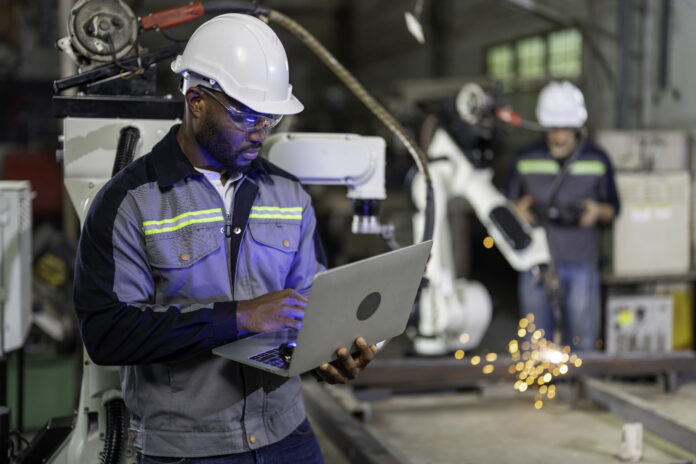Digital Transformation is one of the most fundamental changes in the history of humankind. In combination with smart automation, advanced robotics and additive manufacturing it revolutionizes the principles of manufacturing. From a business perspective this is tantamount to a paradigm shift. As success factors change dramatically, this can be a challenge for established companies. How to avoid the pitfalls of Incumbent Paralysis? And what are the implications for machinery?
Digital Transformation as a Trigger
Production is all about the product. That is already in the word. So far, so trivial. However, few things are more dangerous than triviality, intellectually speaking. Because triviality is beyond doubt. What is not being questioned, is not reconsidered. And not reconsidering is very risky in times of disruptive change. Now, that’s where all alarm bells should be ringing. Everyone needs to keep reminding themselves that we are living in times of fundamental change. Not questioning one’s own mindset is a proven recipe for failure when facing a paradigm shift. This mental bias is well know, but that does not immunize against it. So in manufacturing everyone is well advised to ask: How could production be affected? How could the very basic certainties of manufacturing be challenged?
Traditional Paradigm of Manufacturing
Ever since the first Industrial Revolution a product-centered way of thinking has been essential for success in manufacturing. Comparative competitive advantage has been determined mainly by two factors: product quality and product pricing. Particularly in mass production, this is commonsense till today. Given, a company has an innovative product, then market success is regarded to be very much a matter of perfection of production, which is necessary to elevate quality and reduce price. All other areas of business are somewhat considered as inevitable appendages in this school of thinking. Marketing? Necessary, sure. Needed to help the product speak for itself. Customer relations? Really helpful in giving the customer a chance to understand, why the product is of superior quality and unbeatably reasonable price. And so on. Sounds like ironic hyperbole? Maybe, a bit. No offensive intended, just meant as illustration of the main point: The dominant mindset by many in manufacturing has traditionally been to put focus on perfection of production. And for good reason.
Bringing machinery into the equation, the common thinking mimics the described overall focus. The two main questions asked here are: How can machinery help with product quality? And how can it increase production efficiency? Automation is widely regarded as an enabler of optimization. That has substantial implications for the way innovations in machinery are viewed. They are often evaluated primarily according to their ability to fit into the production process. The mindset mirrors the general attitude: In manufacturing many regard machinery as means for perfection of production.
This very mindset has proven to be extremely successful over the course of the last two centuries. And manufacturing has experienced a constant stream of innovations during that time. What should be different all of a sudden? Never change a winning strategy, they say. So why are we talking? Paradigm shift!
Paradigm Shift and Incumbent Paralysis
Paradigm shift is the abrupt alteration in the set of overarching assumptions, which are forming the intellectual foundation of a general worldview. It is a change in the baseline believes, that are taken for granted to be true. Consequently, a paradigm shift creates a situation in which the established mindset becomes a trap. Holding on to outdated assumptions carries the risk of misjudgement and poor decisions. This risk affects particularly those, who owe their success to their superior understanding of the old paradigm. Often they are inclined to cling to their longheld mindset. Understandably, as this has been a proven success strategy for them. This is a common phenomenon: Incumbent Paralysis is the inability of established players to adapt adequately to a paradigm shift. What helps to avoid it? Well, a little self-reflection never goes amiss. The result might be: There could be a new reality on the horizon.
Digital Era Paradigm of Manufacturing
Digital Transformation is widely agreed to be tantamount to a paradigm shift. However, manufacturing is still believed by many to be immune to such digitalization induced paradigm shift. Manufacturing is all about creating physical objects. Cyberspace is thought to be completely separate from the physical world. Therefore, this is not going to change the industrial business model at its core, many say.
Nevertheless, established champions get already challenged by digital innovators. The latter tend to think differently about manufacturing. Some don’t even bother to consider the traditional logic, let alone to adhere to it. They operate under a very different paradigm: Production is regarded as part of an integrated system of value generation, whose center of gravity is in the digital infosphere. Under the new paradigm, production is conceptualized merely as a link between cyberspace and physical entisphere. Consequently, these new players are looking differently at machinery, too. It is regarded as device that functions as an interface between infosphere and entisphere, which enables the materialization of information. A device to convert information into physical objects. It is understood as a means to extend digital systems into the physical reality. This has far reaching implications. While in the traditional mindset machinery is about the optimization of the production process, the new mindset focuses on machinery as vehicle to establish a new logic of value creation, that takes an integrated approach to problem solving in a digital world.
Advanced robotics, smart machinery and additive manufacturing enable new forms of production that are directly steered by information processing. With artificial intelligence, machine learning and data science becoming the mind behind the machine, this allows to reconfigure the process of production. Further, the network structure of the digital infosphere enables new forms of interaction with other relevant stakeholders in the market. Characteristic is a reconfiguration of the value architecture from linear value chains, in which manufacturers are the center, to loosely knotted nets, that are highly adaptive. Together, all of this gives rise to new success factors: Flexibility, adaptivity, decentralization, individualization, customization and network integration become key to success in the digital era.
Implications for Machinery Upgrading
Will this apply to all manufacturing? No, of course not. Some branches will be more affected than others. But that should not be an excuse not to explore the new paradigm. Such mental laziness could cost one dearly. One needs to be vigilant to assess whether the own business model is affected. Why emphasis this so much? Paradigm shift is not a new phenomenon. The disruptive potential of innovation is being discussed in management boards for decades. Yet, still all to many companies fail due to Incumbent Paralysis. Service industries are facing this challenge as we speak. Industrial production is next in line to be entertained by this experience in the course of progressing digital transformation. Consider yourself warned. Better be prepared. How to do it? Start looking differently at innovations in machinery today! Advanced robotics, smart factories, additive manufacturing, artificial intelligence – this is more than just the next generation of machinery. One should not go about it like in every other regular cycle of machinery update. This time a more comprehensive approach is needed: Whenever one spots a new machine one needs to assess, how it could change the value architecture if combined with digital transformation. This really seems to be key!
Digital transformation alters the structure and the functional logic of societal, economical, technological and political systems. Success is defined by the functional logic of the system in which one is operating. When a system changes, the success factors change, too. When a system’s structure is reconfigured, when it’s functional logic is altered, then it is likely that the very conditions for success will also change. What it takes to be successful will be different. Being best in class is meaningless when the discipline becomes irrelevant. Implication for manufacturing:
Perfection of production might perhaps no longer be the single highest priority when the whole business logic changes. Other success factors might gain relevance. Innovation in machinery is both in this: trigger and cure. It causes the paradigm shift and it helps to be successful under the regime of the new one. How to address the challenge? Think out of the paradigm!
About the Author
Dr. oec. HSG Dr. phil. Jörn Lengsfeld is a German economist, management expert and communication scientist. He holds research doctorates from the University of St. Gallen (doctor oeconomiae) and the Philosophical Faculty of the University of Erfurt (doctor philosophiae). Learn more about him and his work on his website, joernlengsfeld.com, or contact him at mail@joernlengsfeld.com.






















